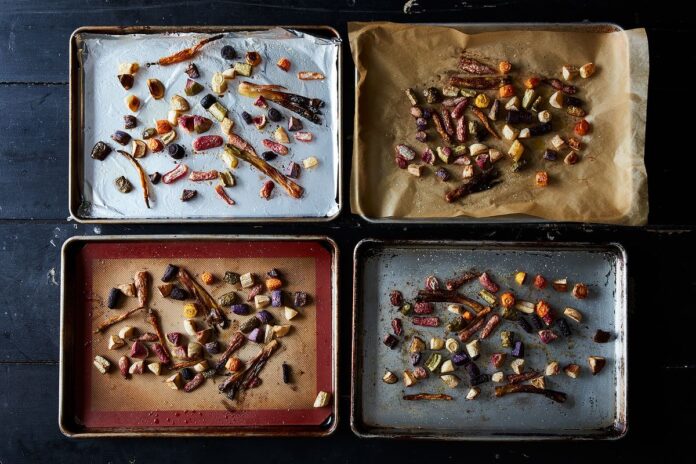Whether I roast my vegetables on parchment paper or directly on a baking sheet has nothing to do with recipe or technique and everything to do with laziness. I did a quick calculation in my head: Which took more effort—cleaning a greasy baking sheet later, or bending over, opening a drawer, and cutting a piece of parchment paper now?
Since I want to live in the moment (or, um, just minimize most of it urge pain in my butt), I usually choose to bake without the coating (which, yes, means more fat removal later).
But, for vegetables, how do I prepare a wok make difference?
Photo by James Ransom
It turns out—at least in our experiments—that's exactly what happened my strange decision making paid off (or at least, in the case of reliable roasted vegetables, it hasn't done me any harm). Unless you're grilling something delicate, or looking for blonde slices and pieces, the way you line a pan for standard baked potatoes won't produce a very large difference.
When we roasted four radishes, turnips, and carrots of the same size and oiled in the same way for Roasted Spring Roots with Horseradish Thyme Butter, we were surprised by how difficult it was to deem one tray as the “best roast.” Try to spot some of the differences in the baking pans below—it's hard!
Photo by James Ransom
But take a look at the image below, and you might be able to convince yourself of some subtle variations. Yes!
- Root vegetables roasted on an empty baking sheet have the crispiest, glossiest edges—the most traditional are the ones that “look roasted.”
- The batch baked on parchment had the most uniform color, with fewer burnt or heavily colored areas. Compare, in the image below, radishes—which are the first row—and carrots—which are the second row—roasted directly on a baking sheet (first column) versus on parchment (last column). It's easy to see—and understand—how placing a protective layer between the vegetables and the superheated sheet tray changes the way heat is transferred and, consequently, the way the vegetables cook.
- Vegetables baked on a nonstick silicone mat and on aluminum foil are in the (very small) middle of the spectrum—between vegetables cooked directly on the baking sheet versus vegetables protected by a sheet of parchment.
Photo by James Ransom
Wondering if there is a standard recommendation, I did a little cross referencing:
- In our guide to roasting any vegetable, we recommend parchment paper—no question (or explanation provided).
- But we have plenty of recipes in the archives that call for foil or completely bare (in terms of lining the sheets). In Merrill's recipe for Crispy and Tender Roasted Root Vegetables, she says to “line a baking sheet with parchment (or don't if you're lazy like me and don't mind the extra caramelization).” (Hey Merrill, I'm with you!)
- In the Enjoy your food'S The Ultimate Guide to Roasting Your Vegetablesthey don't recommend layering the skillet with broccoli, brussels sprouts, squash, carrots, cauliflower, or sweet potatoes. Simply grease the florets or slices and place them directly on the baking sheet.
- Together with Emma Christensen at The Kitchn And Melissa Clark for the New York Times. And Ina too!
- At Serious Eats' The Food Lab, J. Kenji López-Alt likes foil-lined sheets for carrot, Brussels sprouts, cauliflowerAnd mold.
Photo by James Ransom
What's a home cook—and a lazy but picky one—to do? Faced with few definite answers, this is what I concluded (and I hope you'll share your findings in the comments below!):
- To reduce caramelization (and make cleanup easier), line with foil, nonstick baking mats, or—for the doughiest results—parchment paper. These three layers function as a barrier between the heat-conducting baking sheet and your food. But because parchment and silicone are both nonstick, and aluminum foil—unless specifically labeled—is not, they will brown the edges less and don't require as much oil.. (While I don't see a difference between foil and silicone roasted vegetables, there are too many variables at play to make a definitive decision.)
- The first principle is useful not only for vegetables that you want to keep soft throughout, but also for delicate ingredients that burn easily (think thinly sliced onions, mandoline potatoes that you don't want to turn into chips, honey leeks and radishes , kale leaves). Consider lining the baking sheet, if only to protect it from the extreme heat of the baking sheet and get a little insurance, buying the time between delicious and ruined. (You'll see in our first photo that all of our little leeks are burnt except for those using parchment.)
- For anything soupy—like watery fruits or vegetables that will release a lot of moisture when roasted (think: tomatoes and strawberries)—the goal is definitely not to make the fruit crunchy. I would use foil or parchment. You don't want to burn it—and the messy liquid will be easier to direct (you don't want to lose the juice and syrup!) on the lined sheet.
- But for starchy, nutritious vegetables—squash, broccoli, cauliflower, Brussels sprouts—the brownest pieces are the ones you pick first, roast them directly on a baking sheet. And enjoy the results! (Then prepare dish soap.)
Photo by James Ransom
When do you line a pan for roasted vegetables and when do you leave it empty? Tell us in the comments below!


